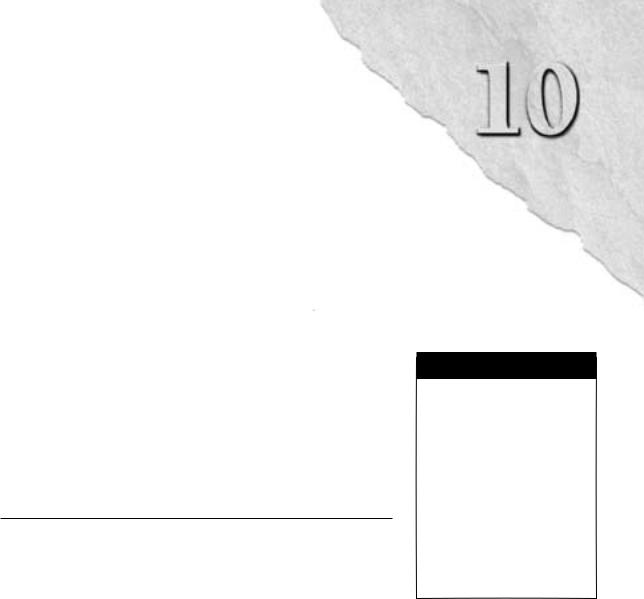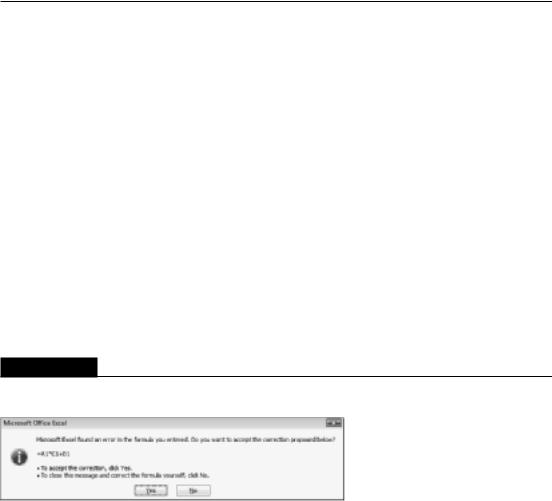
- •About the Author
- •About the Technical Editor
- •Credits
- •Is This Book for You?
- •Software Versions
- •Conventions This Book Uses
- •What the Icons Mean
- •How This Book Is Organized
- •How to Use This Book
- •What’s on the Companion CD
- •What Is Excel Good For?
- •What’s New in Excel 2010?
- •Moving around a Worksheet
- •Introducing the Ribbon
- •Using Shortcut Menus
- •Customizing Your Quick Access Toolbar
- •Working with Dialog Boxes
- •Using the Task Pane
- •Creating Your First Excel Worksheet
- •Entering Text and Values into Your Worksheets
- •Entering Dates and Times into Your Worksheets
- •Modifying Cell Contents
- •Applying Number Formatting
- •Controlling the Worksheet View
- •Working with Rows and Columns
- •Understanding Cells and Ranges
- •Copying or Moving Ranges
- •Using Names to Work with Ranges
- •Adding Comments to Cells
- •What Is a Table?
- •Creating a Table
- •Changing the Look of a Table
- •Working with Tables
- •Getting to Know the Formatting Tools
- •Changing Text Alignment
- •Using Colors and Shading
- •Adding Borders and Lines
- •Adding a Background Image to a Worksheet
- •Using Named Styles for Easier Formatting
- •Understanding Document Themes
- •Creating a New Workbook
- •Opening an Existing Workbook
- •Saving a Workbook
- •Using AutoRecover
- •Specifying a Password
- •Organizing Your Files
- •Other Workbook Info Options
- •Closing Workbooks
- •Safeguarding Your Work
- •Excel File Compatibility
- •Exploring Excel Templates
- •Understanding Custom Excel Templates
- •Printing with One Click
- •Changing Your Page View
- •Adjusting Common Page Setup Settings
- •Adding a Header or Footer to Your Reports
- •Copying Page Setup Settings across Sheets
- •Preventing Certain Cells from Being Printed
- •Preventing Objects from Being Printed
- •Creating Custom Views of Your Worksheet
- •Understanding Formula Basics
- •Entering Formulas into Your Worksheets
- •Editing Formulas
- •Using Cell References in Formulas
- •Using Formulas in Tables
- •Correcting Common Formula Errors
- •Using Advanced Naming Techniques
- •Tips for Working with Formulas
- •A Few Words about Text
- •Text Functions
- •Advanced Text Formulas
- •Date-Related Worksheet Functions
- •Time-Related Functions
- •Basic Counting Formulas
- •Advanced Counting Formulas
- •Summing Formulas
- •Conditional Sums Using a Single Criterion
- •Conditional Sums Using Multiple Criteria
- •Introducing Lookup Formulas
- •Functions Relevant to Lookups
- •Basic Lookup Formulas
- •Specialized Lookup Formulas
- •The Time Value of Money
- •Loan Calculations
- •Investment Calculations
- •Depreciation Calculations
- •Understanding Array Formulas
- •Understanding the Dimensions of an Array
- •Naming Array Constants
- •Working with Array Formulas
- •Using Multicell Array Formulas
- •Using Single-Cell Array Formulas
- •Working with Multicell Array Formulas
- •What Is a Chart?
- •Understanding How Excel Handles Charts
- •Creating a Chart
- •Working with Charts
- •Understanding Chart Types
- •Learning More
- •Selecting Chart Elements
- •User Interface Choices for Modifying Chart Elements
- •Modifying the Chart Area
- •Modifying the Plot Area
- •Working with Chart Titles
- •Working with a Legend
- •Working with Gridlines
- •Modifying the Axes
- •Working with Data Series
- •Creating Chart Templates
- •Learning Some Chart-Making Tricks
- •About Conditional Formatting
- •Specifying Conditional Formatting
- •Conditional Formats That Use Graphics
- •Creating Formula-Based Rules
- •Working with Conditional Formats
- •Sparkline Types
- •Creating Sparklines
- •Customizing Sparklines
- •Specifying a Date Axis
- •Auto-Updating Sparklines
- •Displaying a Sparkline for a Dynamic Range
- •Using Shapes
- •Using SmartArt
- •Using WordArt
- •Working with Other Graphic Types
- •Using the Equation Editor
- •Customizing the Ribbon
- •About Number Formatting
- •Creating a Custom Number Format
- •Custom Number Format Examples
- •About Data Validation
- •Specifying Validation Criteria
- •Types of Validation Criteria You Can Apply
- •Creating a Drop-Down List
- •Using Formulas for Data Validation Rules
- •Understanding Cell References
- •Data Validation Formula Examples
- •Introducing Worksheet Outlines
- •Creating an Outline
- •Working with Outlines
- •Linking Workbooks
- •Creating External Reference Formulas
- •Working with External Reference Formulas
- •Consolidating Worksheets
- •Understanding the Different Web Formats
- •Opening an HTML File
- •Working with Hyperlinks
- •Using Web Queries
- •Other Internet-Related Features
- •Copying and Pasting
- •Copying from Excel to Word
- •Embedding Objects in a Worksheet
- •Using Excel on a Network
- •Understanding File Reservations
- •Sharing Workbooks
- •Tracking Workbook Changes
- •Types of Protection
- •Protecting a Worksheet
- •Protecting a Workbook
- •VB Project Protection
- •Related Topics
- •Using Excel Auditing Tools
- •Searching and Replacing
- •Spell Checking Your Worksheets
- •Using AutoCorrect
- •Understanding External Database Files
- •Importing Access Tables
- •Retrieving Data with Query: An Example
- •Working with Data Returned by Query
- •Using Query without the Wizard
- •Learning More about Query
- •About Pivot Tables
- •Creating a Pivot Table
- •More Pivot Table Examples
- •Learning More
- •Working with Non-Numeric Data
- •Grouping Pivot Table Items
- •Creating a Frequency Distribution
- •Filtering Pivot Tables with Slicers
- •Referencing Cells within a Pivot Table
- •Creating Pivot Charts
- •Another Pivot Table Example
- •Producing a Report with a Pivot Table
- •A What-If Example
- •Types of What-If Analyses
- •Manual What-If Analysis
- •Creating Data Tables
- •Using Scenario Manager
- •What-If Analysis, in Reverse
- •Single-Cell Goal Seeking
- •Introducing Solver
- •Solver Examples
- •Installing the Analysis ToolPak Add-in
- •Using the Analysis Tools
- •Introducing the Analysis ToolPak Tools
- •Introducing VBA Macros
- •Displaying the Developer Tab
- •About Macro Security
- •Saving Workbooks That Contain Macros
- •Two Types of VBA Macros
- •Creating VBA Macros
- •Learning More
- •Overview of VBA Functions
- •An Introductory Example
- •About Function Procedures
- •Executing Function Procedures
- •Function Procedure Arguments
- •Debugging Custom Functions
- •Inserting Custom Functions
- •Learning More
- •Why Create UserForms?
- •UserForm Alternatives
- •Creating UserForms: An Overview
- •A UserForm Example
- •Another UserForm Example
- •More on Creating UserForms
- •Learning More
- •Why Use Controls on a Worksheet?
- •Using Controls
- •Reviewing the Available ActiveX Controls
- •Understanding Events
- •Entering Event-Handler VBA Code
- •Using Workbook-Level Events
- •Working with Worksheet Events
- •Using Non-Object Events
- •Working with Ranges
- •Working with Workbooks
- •Working with Charts
- •VBA Speed Tips
- •What Is an Add-In?
- •Working with Add-Ins
- •Why Create Add-Ins?
- •Creating Add-Ins
- •An Add-In Example
- •System Requirements
- •Using the CD
- •What’s on the CD
- •Troubleshooting
- •The Excel Help System
- •Microsoft Technical Support
- •Internet Newsgroups
- •Internet Web sites
- •End-User License Agreement

CHAPTER
Introducing Formulas
and Functions
Formulas are what make a spreadsheet program so useful. If it weren’t for formulas, a spreadsheet would simply be a glorified word-processing document that has great support for tabular information. You use for-
mulas in your Excel worksheets to calculate results from the data stored in the worksheet. When data changes, the formulas calculate updated results with no extra effort on your part. This chapter introduces formulas and functions and helps you get up to speed with this important element.
IN THIS CHAPTER
Understanding formula basics
Entering formulas and functions into your worksheets
Understanding how to use references in formulas
Understanding Formula Basics
A formula consists of special code entered into a cell. It performs a calculation of some type and returns a result, which is displayed in the cell. Formulas use a variety of operators and worksheet functions to work with values and text. The values and text used in formulas can be located in other cells, which makes changing data easy and gives worksheets their dynamic nature. For example, you can see multiple scenarios quickly by changing the data in a worksheet and letting your formulas do the work.
A formula can consist of any of these elements:
•Mathematical operators, such as + (for addition) and * (for multiplication)
•Cell references (including named cells and ranges)
•Values or text
•Worksheet functions (such as SUM or AVERAGE)
Correcting common formula errors
Using advanced naming techniques
Tips for working with formulas
195

Part II: Working with Formulas and Functions
Note
When you’re working with a table, a feature introduced in Excel 2007 enables you to create formulas that use column names from the table — which can make your formulas much easier to read. I discuss table formulas later in this chapter. (See “Using Formulas In Tables.”) n
After you enter a formula, the cell displays the calculated result of the formula. The formula itself appears in the Formula bar when you select the cell, however.
Here are a few examples of formulas:
=150*.05 |
Multiplies 150 times 0.05. This formula uses only values, and it |
|
always returns the same result. You could just enter the value 7.5 |
|
into the cell. |
=A1+A2 |
Adds the values in cells A1 and A2. |
=Income–Expenses |
Subtracts the value in the cell named Expenses from the value in |
|
the cell named Income. |
=SUM(A1:A12) |
Adds the values in the range A1:A12. |
=A1=C12 |
Compares cell A1 with cell C12. If the cells are identical, the formula |
|
returns TRUE; otherwise, it returns FALSE. |
Tip
Formulas always begin with an equal sign so that Excel can distinguish them from text. n
Using operators in formulas
Excel lets you use a variety of operators in your formulas. Operators are symbols that indicate what mathematical operation you want the formula to perform. Table 10.1 lists the operators that Excel recognizes. In addition to these, Excel has many built-in functions that enable you to perform additional calculations.
TABLE 10.1
|
Operators Used in Formulas |
Operator |
Name |
|
|
+ |
Addition |
|
|
– |
Subtraction |
|
|
* |
Multiplication |
|
|
/ |
Division |
|
|
^ |
Exponentiation |
|
|
& |
Concatenation |
|
|
196

|
Chapter 10: Introducing Formulas and Functions |
|
|
|
|
Operator |
Name |
|
|
= |
Logical comparison (equal to) |
|
|
> |
Logical comparison (greater than) |
|
|
< |
Logical comparison (less than) |
|
|
>= |
Logical comparison (greater than or equal to) |
|
|
<= |
Logical comparison (less than or equal to) |
|
|
<> |
Logical comparison (not equal to) |
|
|
You can, of course, use as many operators as you need to perform the desired calculation.
Here are some examples of formulas that use various operators.
Formula |
What It Does |
=”Part-”&”23A” |
Joins (concatenates) the two text strings to produce Part-23A. |
=A1&A2 |
Concatenates the contents of cell A1 with cell A2. Concatenation |
|
works with values as well as text. If cell A1 contains 123 and cell A2 |
|
contains 456, this formula would return the text 123456. |
=6^3 |
Raises 6 to the third power (216). |
=216^(1/3) |
Raises 216 to the 1/3 power. This is mathematically equivalent to cal- |
|
culating the cube root of 216, which is 6. |
=A1<A2 |
Returns TRUE if the value in cell A1 is less than the value in cell A2. |
|
Otherwise, it returns FALSE. Logical-comparison operators also work |
|
with text. If A1 contains Bill and A2 contains Julia, the formula |
|
would return TRUE because Bill comes before Julia in alphabetical |
|
order. |
=A1<=A2 |
Returns TRUE if the value in cell A1 is less than or equal to the value |
|
in cell A2. Otherwise, it returns FALSE. |
=A1<>A2 |
Returns TRUE if the value in cell A1 isn’t equal to the value in cell A2. |
|
Otherwise, it returns FALSE. |
Understanding operator precedence in formulas
When Excel calculates the value of a formula, it uses certain rules to determine the order in which the various parts of the formula are calculated. You need to understand these rules if you want your formulas to produce the desired results.
Table 10.2 lists the Excel operator precedence. This table shows that exponentiation has the highest precedence (performed first) and logical comparisons have the lowest precedence (performed last).
197

Part II: Working with Formulas and Functions
TABLE 10.2
Operator Precedence in Excel Formulas
Symbol |
Operator |
Precedence |
|
|
|
^ |
Exponentiation |
1 |
|
|
|
* |
Multiplication |
2 |
|
|
|
/ |
Division |
2 |
|
|
|
+ |
Addition |
3 |
|
|
|
– |
Subtraction |
3 |
|
|
|
& |
Concatenation |
4 |
|
|
|
= |
Equal to |
5 |
|
|
|
< |
Less than |
5 |
|
|
|
> |
Greater than |
5 |
|
|
|
You can use parentheses to override the Excel’s built-in order of precedence. Expressions within parentheses are always evaluated first. For example, the following formula uses parentheses to control the order in which the calculations occur. In this case, cell B3 is subtracted from cell B2, and the result is multiplied by cell B4:
=(B2-B3)*B4
If you enter the formula without the parentheses, Excel computes a different answer. Because multiplication has a higher precedence, cell B3 is multiplied by cell B4. Then this result is subtracted from cell B2, which isn’t what was intended.
The formula without parentheses looks like this:
=B2-B3*B4
It’s a good idea to use parentheses even when they aren’t strictly necessary. Doing so helps to clarify what the formula is intended to do. For example, the following formula makes it perfectly clear that B3 should be multiplied by B4, and the result subtracted from cell B2. Without the parentheses, you would need to remember Excel’s order of precedence.
=B2-(B3*B4)
You can also nest parentheses within formulas — that is, put them inside other parentheses. If you do so, Excel evaluates the most deeply nested expressions first — and then works its way out. Here’s an example of a formula that uses nested parentheses:
=((B2*C2)+(B3*C3)+(B4*C4))*B6
198

Chapter 10: Introducing Formulas and Functions
This formula has four sets of parentheses — three sets are nested inside the fourth set. Excel evaluates each nested set of parentheses and then sums the three results. This result is then multiplied by the value in cell B6.
Although the preceding formula uses four sets of parentheses, only the outer set is really necessary. If you understand operator precedence, it should be clear that you can rewrite this formula as:
=(B2*C2+B3*C3+B4*C4)*B6
But most would agree that using the extra parentheses makes the calculation much clearer.
Every left parenthesis, of course, must have a matching right parenthesis. If you have many levels of nested parentheses, keeping them straight can sometimes be difficult. If the parentheses don’t match, Excel displays a message explaining the problem — and won’t let you enter the formula.
Caution
In some cases, if your formula contains mismatched parentheses, Excel may propose a correction to your formula. Figure 10.1 shows an example of the Formula AutoCorrect feature. You may be tempted simply to accept the proposed correction, but be careful — in many cases, the proposed formula, although syntactically correct, isn’t the formula you intended, and it will produce an incorrect result. n
FIGURE 10.1
The Excel Formula AutoCorrect feature sometimes suggests a syntactically correct formula, but not the formula you had in mind.
Tip
Excel lends a hand in helping you match parentheses. When the insertion point moves over a parenthesis while you’re editing a cell, Excel momentarily makes the parenthesis character bold and displays it in a different color — and does the same with its matching parenthesis. n
Using functions in your formulas
Many formulas you create use worksheet functions. These functions enable you to greatly enhance the power of your formulas and perform calculations that are difficult (or even impossible) if you use only the operators discussed previously. For example, you can use the TAN function to calculate the tangent of an angle. You can’t do this complicated calculation by using the mathematical operators alone.
199

Part II: Working with Formulas and Functions
Examples of formulas that use functions
A worksheet function can simplify a formula significantly.
Here’s an example. To calculate the average of the values in 10 cells (A1:A10) without using a function, you’d have to construct a formula like this:
=(A1+A2+A3+A4+A5+A6+A7+A8+A9+A10)/10
Not very pretty, is it? Even worse, you would need to edit this formula if you added another cell to the range. Fortunately, you can replace this formula with a much simpler one that uses one of Excel’s built-in worksheet functions, AVERAGE:
=AVERAGE(A1:A10)
The following formula demonstrates how using a function can enable you to perform calculations that are not otherwise possible. Say you need to determine the largest value in a range. A formula can’t tell you the answer without using a function. Here’s a formula that uses the MAX function to return the largest value in the range A1:D100:
=MAX(A1:D100)
Functions also can sometimes eliminate manual editing. Assume that you have a worksheet that contains 1,000 names in cells A1:A1000, and the names appear in all-capital letters. Your boss sees the listing and informs you that the names will be mail-merged with a form letter. All-uppercase letters is not acceptable; for example, JOHN F. SMITH must now appear as John F. Smith. You could spend the next several hours re-entering the list — ugh — or you could use a formula, such as the following, which uses the PROPER function to convert the text in cell A1 to the proper case:
=PROPER(A1)
Enter this formula once in cell B1 and then copy it down to the next 999 rows. Then select B1:B1000 and choose Home Clipboard Copy to copy the range. Next, with B1:B1000 still selected, choose Home Clipboard Paste Values (V) to convert the formulas to values. Delete the original column, and you’ve just accomplished several hours of work in less than a minute.
One last example should convince you of the power of functions. Suppose you have a worksheet that calculates sales commissions. If the salesperson sold more than $100,000 of product, the commission rate is 7.5 percent; otherwise, the commission rate is 5.0 percent. Without using a function, you would have to create two different formulas and make sure that you use the correct formula for each sales amount. A better solution is to write a formula that uses the IF function to ensure that you calculate the correct commission, regardless of sales amount:
=IF(A1<100000,A1*5%,A1*7.5%)
This formula performs some simple decision-making. The formula checks the value of cell A1. If this value is less than 100,000, the formula returns cell A1 multiplied by 5 percent. Otherwise, it returns what’s in cell A1, multiplied by 7.5 percent. This example uses three arguments, separated by commas. I discuss this in the upcoming section, “Function arguments.”
200

Chapter 10: Introducing Formulas and Functions
New Functions in Excel 2010
New Feature
Excel 2010 contains more than 50 new worksheet functions. n
But, before you get too excited, understand that nearly all the new functions are simply improved versions of existing statistical functions. For example, you’ll find five new functions that deal with the Chi Square distribution: CHISQ.DIST, CHISQ.DIST.RT, CHISQ.INV, CHISQ.INV.RT, and CHISQ. TEST. These are very specialized functions, and the average Excel user will have no need for them.
Excel 2010 offers only three new functions that might appeal to a more general audience:
•AGGREGATE: A function that calculates sums, averages, and so on, with the ability to ignore errors and/or hidden rows.
•NETWORKDAYS.INTL: An international version of the NETWORKDAYS function, which returns the number of workdays between two dates.
•WORKDAY.INTL: An international version of the WORKDAY function, which returns a date before or after a specified number of workdays.
Keep in mind that if you use any of these new functions, you can’t share your workbook with someone who uses an earlier version of Excel.
Function arguments
In the preceding examples, you may have noticed that all the functions used parentheses. The information inside the parentheses is the list of arguments.
Functions vary in how they use arguments. Depending on what it has to do, a function may use
•No arguments
•One argument
•A fixed number of arguments
•An indeterminate number of arguments
•Optional arguments
An example of a function that doesn’t use an argument is the NOW function, which returns the current date and time. Even if a function doesn’t use an argument, you must still provide a set of empty parentheses, like this:
=NOW()
If a function uses more than one argument, you must separate each argument with a comma. The examples at the beginning of the chapter used cell references for arguments. Excel is quite flexible when it comes to function arguments, however. An argument can consist of a cell reference, literal
201
